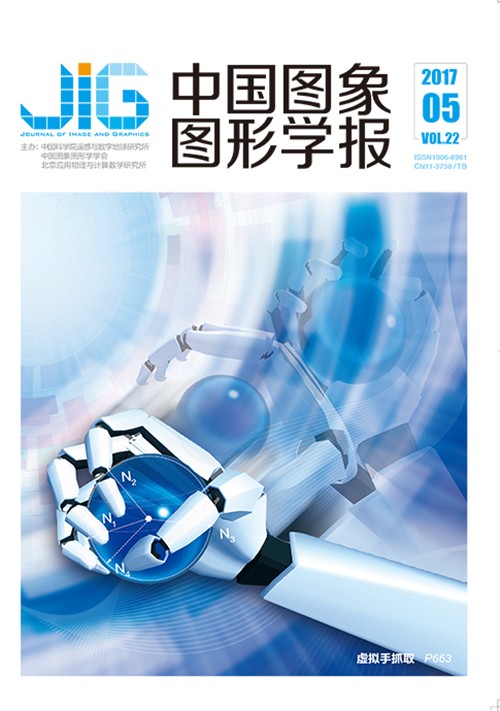
结合基因表达式编程与空间模糊聚类的图像分割
摘 要
目的 针对模糊C-均值聚类图像分割方法存在的对初始值敏感及抗噪性能差的问题,提出一种结合基因表达式编程与空间模糊聚类的图像分割方法。方法 首先,利用基因表达式编程算法对图像进行初次分割,即将聚类中心编码成染色体,通过适应度评价引导搜索获得优化的聚类中心;然后在隶属度计算中引入空间函数,以初次分割结果作为初始值,使用空间模糊聚类对图像进行二次分割。结果 对加噪的合成图像和Berkeley图像的分割实验显示,本文方法在聚类划分系数(VPC)、聚类划分熵(VPE)和峰值信噪比(PSNR)等评价指标上总体性能优于经典的模糊C-均值聚类和空间模糊C-均值聚类分割算法,其中VPC值平均高出0.062 4和0.061 1,VPE值平均降低0.117 0和0.101 1,而PSNR值平均提升了约13.312 1 dB和3.308 4 dB;在对Berkeley图像库中的6幅图片的分割实验显示,本文方法对图像分割的VPC值均在0.93以上,相比两种对比方法平均提高0.157 6和0.013 3,VPE值保持在0.1附近,均低于对比方法,PSNR值平均提高2.896 3 dB和1.934 4 dB;在多目标分割实验上,随着聚类数目增加,3种方法的分割性能均有下降,但本文方法性能曲线最为平缓,受聚类数目的影响最小。虽然本文方法所需的运行时间略有增加,但求解所需的迭代次数却极大地减少。结论 本文提出的图像分割方法具有很强的抗噪性、更高的分割精度和稳定性,适用于需要更精确结果、对时间要求不高的分割场景。
关键词
Image segmentation based on gene expression programming and spatial fuzzy clustering
Li Tingting1, Jiang Zhaohui1,2, Rao Yuan1,2, Zhang Xiaoming1(1.School of Information and Computer Science, Anhui Agriculture University, Hefei 230036, China;2.Key Laboratory of Technology and Application in Internet of Things, Ministry of Agriculture, P. R. China, Hefei 230036, China) Abstract
Objective sensitivity to the initial value and poor anti-noise performance are two important factors affecting fuzzy c-mean (FCM) clustering in image segmentation. In this study, image segmentation based on gene expression programming (GEP) and spatial fuzzy clustering is proposed to solve the two problems. GEP is a novel adaptive evolutionary algorithm that can solve the problems by simulating biological gene structure and genetic evolution. The performance of GEP is excellent, and it currently has a few applications in remote-sensing image segmentation. The standard FCM only deals with the gray-level information of pixels. However, the pixels on an image are highly correlated, and the pixels within the neighborhood have almost the same data characteristics. Therefore, the spatial relationships among adjacent pixels must be considered an important feature in image segmentation. The GEP owns a unique structure, a more flexible coding method, and a richer genetic operator, which make it a better search method compared with other methods. Method In the proposed method, the GEP algorithm is introduced for the initial segmentation at the first stage. The clustering centers are encoded into chromosomes as the action objects in GEP. With genetic operations, namely, selection, recombination, and mutation, chromosomes that represent individuals will evolve to the next generation. Fitness function is used to evaluate each individual, which is set as the reciprocal of the objective function in the FCM in this study. After a certain number of evolutions, the individual with the highest fitness value will then be kept as the initial solution. At the second stage, spatial function is introduced to reduce the adverse effects of noise points on the image segmentation. With spatial function values of pixels included, the membership function is redefined. The overall process of spatial fuzzy clustering is the same as that of FCM; however, the initial value is from the result of the first stage. Result The segmentation experiments on noisy synthetic image and noisy Berkeley images show that the performances of the proposed method in index partition coefficient (VPC), clustering entropy (VPE), and peak signal-to-noise ratio (PSNR) are much better than those of the other two classical clustering segmentation algorithms. The average VPC values are 0.062 4 and 0.061 1 higher than those of the classical algorithms. The average VPE decreases by 0.117 0 and 0.101 1, and the average PSNR increases by approximately 13.312 1 and 3.308 4. Although the run time required for this method increases, the number of iterations required for the solution is greatly reduced. The segmentation experiments of six images in the Berkeley image library show that the VPC values of the proposed method are all above 0.93, which is 0.157 6 and 0.013 3 higher than the values of the two comparison methods. The mean value of PSNR increases by 2.896 3 and 1.934 4, and the VPE values are in the vicinity of 0.1 and are lower than the comparison methods. On the multi-target segmentation experiment, the segmentation performance of the three methods decreases with an increase in the number of clusters. However, the performance curve of the proposed method is the smoothest, and the results are the least affected by the number of clusters. Conclusion The proposed method has strong capabilities of anti-noise, high segmentation accuracy, and stability. This method is suitable for the segmentation scenario, in which highly accurate results are required and time requirements are not high.
Keywords
|



 中国图象图形学报 │ 京ICP备05080539号-4 │ 本系统由
中国图象图形学报 │ 京ICP备05080539号-4 │ 本系统由